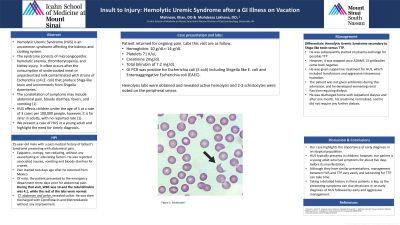Tuesday Poster Session
Category: Colon
P3049 - Insult to Injury: HUS After a GI Illness on Vacation
Tuesday, October 24, 2023
10:30 AM - 4:00 PM PT
Location: Exhibit Hall

Has Audio
- MK
Mahnoor Khan, DO
Mount Sinai South Nassau
Oceanside, NY
Presenting Author(s)
Muhddesa Lakhana, DO, Mahnoor Khan, DO
Mount Sinai South Nassau, Oceanside, NY
Introduction: Hemolytic Uremic Syndrome (HUS) is an uncommon syndrome affecting the kidneys and clotting system. The syndrome consists of microangiopathic hemolytic anemia, thrombocytopenia, and kidney injury. It often occurs after the consumption of undercooked meat or unpasteurized milk contaminated with strains of Escherichia coli (E. coli) that produce Shiga-like toxin and uncommonly from Shigella dysenteries. The symptoms may include abdominal pain, bloody diarrhea, fevers, and vomiting. HUS affects children under the age of 5 at a rate of 3 cases per 100,000 people, however, it is far rarer in adults, with no reported rate [1]. We present a case of HUS in a young adult.
Case Description/Methods: We have a 25-year-old male with a past medical history of Gilbert’s Syndrome presenting with abdominal pain. He described the pain as epigastric, crampy, without any exacerbating or alleviating factors. He also reported nausea, vomiting and bloody diarrhea for a week. He reported that the pain started two days ago after he returned from Mexico. His labs were a hemoglobin of 10, platelets 71, creatinine 2mg/dL and total bilirubin of 7.2. GI PCR was positive for E. coli including Shigella-like E. coli and Enteroaggregative Escherichia coli. Hemolysis labs were obtained and revealed active hemolysis and 2-3 schistocytes were noted on the peripheral smear.
His labs were concerning for HUS secondary to Shiga-like toxin versus TTP. He was subsequently started on plasma exchange for possible TTP; however, it was stopped once ADAMS 13 antibodies came back negative. He was given supportive treatment for HUS, which included transfusions and aggressive intravenous hydration. He developed worsening renal function requiring dialysis. He was discharged home and after one month, his creatinine normalized, and he did not require any further dialysis.
Discussion: Our case highlights the importance of early diagnosis in an atypical population. HUS typically presents in children; however, our patient is a young adult who had symptoms for about five days before its manifestation. Although they have similar presentations, management between HUS and TTP vary vastly and lab testing for TTP can take time. Taking a detailed history in these patients is key, as the presenting symptoms can clue physicians in on early diagnosis of HUS followed by early and aggressive management.
Disclosures:
Muhddesa Lakhana, DO, Mahnoor Khan, DO. P3049 - Insult to Injury: HUS After a GI Illness on Vacation, ACG 2023 Annual Scientific Meeting Abstracts. Vancouver, BC, Canada: American College of Gastroenterology.
Mount Sinai South Nassau, Oceanside, NY
Introduction: Hemolytic Uremic Syndrome (HUS) is an uncommon syndrome affecting the kidneys and clotting system. The syndrome consists of microangiopathic hemolytic anemia, thrombocytopenia, and kidney injury. It often occurs after the consumption of undercooked meat or unpasteurized milk contaminated with strains of Escherichia coli (E. coli) that produce Shiga-like toxin and uncommonly from Shigella dysenteries. The symptoms may include abdominal pain, bloody diarrhea, fevers, and vomiting. HUS affects children under the age of 5 at a rate of 3 cases per 100,000 people, however, it is far rarer in adults, with no reported rate [1]. We present a case of HUS in a young adult.
Case Description/Methods: We have a 25-year-old male with a past medical history of Gilbert’s Syndrome presenting with abdominal pain. He described the pain as epigastric, crampy, without any exacerbating or alleviating factors. He also reported nausea, vomiting and bloody diarrhea for a week. He reported that the pain started two days ago after he returned from Mexico. His labs were a hemoglobin of 10, platelets 71, creatinine 2mg/dL and total bilirubin of 7.2. GI PCR was positive for E. coli including Shigella-like E. coli and Enteroaggregative Escherichia coli. Hemolysis labs were obtained and revealed active hemolysis and 2-3 schistocytes were noted on the peripheral smear.
His labs were concerning for HUS secondary to Shiga-like toxin versus TTP. He was subsequently started on plasma exchange for possible TTP; however, it was stopped once ADAMS 13 antibodies came back negative. He was given supportive treatment for HUS, which included transfusions and aggressive intravenous hydration. He developed worsening renal function requiring dialysis. He was discharged home and after one month, his creatinine normalized, and he did not require any further dialysis.
Discussion: Our case highlights the importance of early diagnosis in an atypical population. HUS typically presents in children; however, our patient is a young adult who had symptoms for about five days before its manifestation. Although they have similar presentations, management between HUS and TTP vary vastly and lab testing for TTP can take time. Taking a detailed history in these patients is key, as the presenting symptoms can clue physicians in on early diagnosis of HUS followed by early and aggressive management.
- Bhandari J, Sedhai YR. Hemolytic Uremic Syndrome. [Updated 2022 Aug 10]. In: StatPearls [Internet]. Treasure Island (FL): StatPearls Publishing; 2023 Jan-.
Disclosures:
Muhddesa Lakhana indicated no relevant financial relationships.
Mahnoor Khan indicated no relevant financial relationships.
Muhddesa Lakhana, DO, Mahnoor Khan, DO. P3049 - Insult to Injury: HUS After a GI Illness on Vacation, ACG 2023 Annual Scientific Meeting Abstracts. Vancouver, BC, Canada: American College of Gastroenterology.
